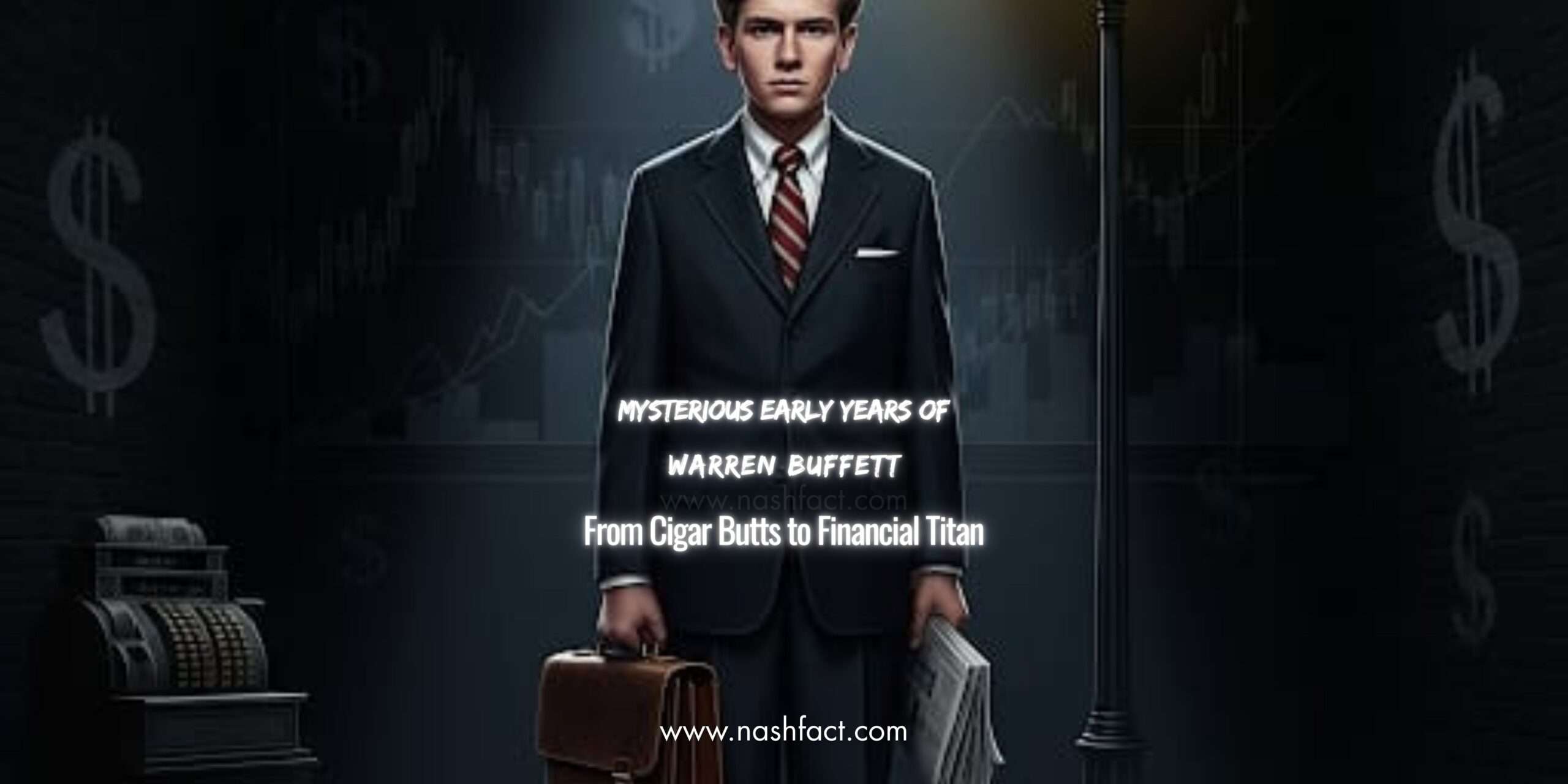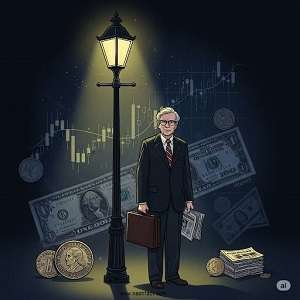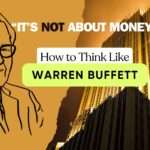- 26 June 2025
- No Comment
- 975
Mysterious Early Years of Warren Buffett: A Hidden Story

It begins not in a bustling bank or the golden halls of Wall Street, but in the still silence of 1930s Omaha, a town wrapped in the dusty cloak of the Great Depression, where even hope seemed rationed. On a modest street shadowed by hardship and humming with uncertainty, a boy wandered, not with toys, but with ticker tapes in hand, his mind dancing through rows of numbers like a magician deciphering ancient runes.
This was no ordinary child. This was Warren Edward Buffett, a boy born under grey skies, into a world cracking at its financial seams. To the untrained eye, he looked no different from the other children on his street, barefoot and curious. But look closer, and you’d see a glint, a quiet intensity, as if he could hear the whispers of numbers when others heard only static.
They called his father Howard, stockbroker, grocer’s son, and later a Congressman. His mother, Leila, strong but wounded by emotional storms, created a home of unpredictable weather. Young Warren learned early to scan more than just balance sheets, he read moods, silences, the ticking of clocks, and the trembling hand of uncertainty.
Omaha may have seemed a far cry from the epicenters of financial power, but for Warren, it was a classroom. While others collected marbles or chased baseballs, he pored over dusty financial reports his father brought home. Numbers were not mere digits, they were stories. They told him of empires built and empires shattered, of risk, reward, and redemption. He didn’t just learn math; he breathed it.
But not all was tidy in this young wizard’s world. Washington, D.C. came calling when Howard won his seat in Congress. The Buffett family uprooted, and Warren, still a boy, suddenly felt like a castaway in a strange land. He rebelled, skipping classes, sneaking into arcades, even slipping golf balls into his pockets that weren’t his.
A minor thief, yes—but only because he hadn’t yet found what he truly wanted to steal: wisdom.
His father, a man of calm conviction, finally confronted him. “You can do better than this.” Those words didn’t scold—they carved a mission. Warren didn’t weep. He calculated. He adjusted his course.
He was barely a teenager when he began his first business ventures—selling chewing gum, delivering newspapers, and memorizing the price of every stock on the board. He wasn’t chasing dollars for toys. He was building something invisible, but unstoppable—a mind that would one day see billions not just as money, but as consequence, power, and purpose.
And yet, this wasn’t the Buffett we’d later come to know—the sage in the sweater vest, the Oracle of Omaha. No, this was a hunter. A young lion who would, within a few short years, move from odd jobs and paper routes to raiding forgotten corners of the market, sniffing out undervalued companies like a hound on the trail. He wasn’t yet the teacher. He was the warrior.
The boy from Omaha was just beginning to rise—not on a horse, but on compound interest.
Not with a sword, but with Benjamin Graham’s The Intelligent Investor in hand. And his legend, like all great legends, was only getting started.
The Cigar Butt Alchemist and the Sanborn Siege
The boy who once combed Omaha’s streets for discarded bottle caps was now entering the hallowed halls of finance—not through the main gates, but through side doors of skepticism and strategy. He wasn’t content to play by the rules; Warren Buffett came to rewrite them.
The road first took him to the Wharton School of Business—an institution dripping in prestige, yet to Buffett, it felt sterile. The lectures were polished but passionless. The numbers were there, but the soul was missing. He wanted more than formulas. He wanted fire. And so, as if guided by fate’s invisible hand, he found himself at Columbia University, standing before the quiet genius who would ignite his transformation: Benjamin Graham.
Graham didn’t speak like the others. He didn’t preach about trends or the frenzy of Wall Street. He whispered truths hidden beneath balance sheets. His voice was soft, but his ideas were weapons.
“Everyone on Wall Street is so smart, their brilliance cancels out.”
To Buffett, this wasn’t just clever. It was liberating.
Graham’s philosophy was as gritty as it was brilliant—“cigar butt” investing: scouring the market for battered companies, still smoldering with one last puff of profit. It wasn’t elegant. It wasn’t popular. But it worked. And Buffett listened like a disciple before a prophet.
Buffett would go on to join Graham-Newman Corp., a sanctuary for value hunters. There, he became a market archaeologist, brushing away dust from overlooked relics—companies dismissed by the crowd but rich with buried value. It was here he became a craftsman of compound interest, a surgeon of intrinsic value. By his mid-20s, he had quietly amassed $19,000, roughly $200,000 today—not from luck, but from discipline sharper than a scalpel.
But destiny does not wait in offices forever. And Buffett was never meant to be an employee.
He was building a kingdom. And the first conquest in his empire? A fading cartographer known as Sanborn Map Company.
The Siege of Sanborn – Buffett’s First Battle
The year was 1958, and Sanborn Maps—an old titan once vital to insurance underwriters—was breathing its last. The world was shifting, and this company, though once powerful, had become an aging relic. But Buffett, always with the soul of an alchemist, saw more than decline.
The stock was trading at $45, but hidden in Sanborn’s books was a treasure: an investment portfolio alone worth $65 per share. It was as if a crumbling castle had gold buried in the cellar—and the guards were too lazy to notice.
Buffett smelled opportunity. But opportunity, in this case, came with a challenge.
To unlock that value, Buffett needed leverage. Control. A seat at the high table. And for that, he needed more shares. So, like a young general rallying troops, he turned to those who trusted him most—his father, mother, aunt Alice, even old friends. One by one, he gathered their gold—not to gamble, but to march.
He soon owned a meaningful slice of Sanborn and demanded entry to the boardroom. There, he encountered a familiar foe in corporate warfare: complacency. The board, happy with their perks and unbothered by shareholder value, scoffed at his plan to liquidate the investment portfolio.
“They were just freeloaders,” Buffett later said—his words as sharp as his mind.
But he didn’t back down.
He doubled his efforts, quietly buying up more stock until he commanded 23% of the company. With power consolidated, he returned to the board not as a guest, but as a conqueror.
He gave them a choice: “Support the liquidation or be removed.”
The old guard folded. Sanborn’s assets were freed. And Buffett? He walked away with a 45% profit—a masterstroke of logic, boldness, and timing.
This victory wasn’t about the money—not entirely. It was a test of tactics, of seeing value where others were blind, and having the courage to claim it. Buffett was no longer the student. He was a raider in a suit, a financial knight proving that control unlocks hidden worth.
The Sanborn victory whispered a new truth into Buffett’s journey: Sometimes, to win in the market, you must first win the boardroom.
The Rise of a Relentless Seeker: From Pink Sheets to Powerful Partnerships
As the dust of Sanborn Maps settled and Buffett’s reputation as a fearless financial tactician grew, a new chapter was quietly preparing to unfold—one that would mark the true beginning of the empire.
It was 1956. Warren Buffett, now 26 and armed with battlefield scars from boardroom brawls and value skirmishes, returned to Omaha—not with fanfare, but with fire in his heart. The young prodigy had outgrown the halls of Graham-Newman and was ready to shape the financial world on his own terms. What he lacked in Wall Street prestige, he made up for in uncanny foresight and absolute trust in numbers. Thus began the Buffett Partnership Ltd.—a modest operation with a bold vision.
With little more than a desk, a phone, and his unwavering belief in value investing, Buffett convinced close friends and family to let him manage their savings. “Give me your faith, and I’ll turn it into fortune,” was the unspoken promise. Each dollar they gave him became sacred, a seed to be planted in the most unlikely soil: obscure, overlooked companies buried in the back pages of “pink sheets,” far from the spotlight of the New York Stock Exchange.
Most were weeds. A few were traps. But Buffett, ever the treasure hunter, searched for the gold needles hidden in haystacks of dirt. And find them he did.
Hustling for Hidden Gold: National Fire & Marine
Among his early gems was National Fire & Marine Insurance Company—a quiet little insurer in Nebraska with undervalued potential. The catch? Most of its shareholders were farmers who didn’t believe their shares were worth much. Buffett’s strategy wasn’t born in boardrooms—it was forged on the backroads of rural Nebraska.
He and his team knocked on doors, explaining calmly to skeptical farmers why their shares mattered—and why he wanted to buy them. Sometimes he was welcomed, sometimes chased off porches. But piece by piece, he gathered stock at a 70% discount. The investment, like most things Buffett touched in those early years, paid off handsomely.
By 1962, just six years into the journey, Buffett had grown his partnership’s assets to $7.2 million—an astronomical leap considering he’d started with just $100. His investments were compounding like wildfire, with annual returns that flirted with the impossible: 100% for five straight years.
Chocolate and Conviction: The Rockwood Gamble
While Buffett’s mind was methodical, his gut instincts were sharpening into something formidable. That became clear in the late 1950s when Rockwood & Co., a struggling Brooklyn chocolate maker, caught his eye.
The company was suffocating under rising cocoa prices, yet Buffett saw a silver lining in its cocoa bean inventory. Jay Pritzker, a sharp investor, suggested a clever tax-dodging arbitrage: swap shares for beans. Graham, Buffett’s mentor, approved a quick flip. But Buffett saw something more.
“Pritzker’s willingness to overpay said everything,” he later reflected. Defying Graham’s rule to never overcommit, Buffett went all in—placing 75% of his personal savings into Rockwood stock. His boldness was rewarded when the shares nearly tripled in value, earning him $13,000—worth over $140,000 in today’s dollars.
This wasn’t just a sweet payday. It marked a turning point. Buffett was no longer just mimicking Graham’s strategies; he was evolving. The Oracle of Omaha was beginning to think on his own terms.
The Dempster Mill Dilemma: Hard Numbers, Harder Lessons
But not every story sparkled. Not every cigar butt gave that final puff of profit without cost.
Back in his home state, Buffett found Dempster Mill Manufacturing—a classic Graham-style opportunity. The company made windmills and farm equipment, and its shares were trading at a fraction of their book value. With dollar signs in his eyes, Buffett began accumulating stock, eventually controlling 70% of the company.
It should have been a slam dunk. But Buffett quickly discovered the hidden rot: an incompetent management team, poor operations, and warehouses filled with unsellable inventory. Dempster was a value trap in disguise.
That’s when Charlie Munger, a sharp-witted lawyer with an investor’s soul, entered the picture. Buffett had met him a year earlier, and now he needed Munger’s clear-eyed counsel. Munger introduced him to Harry Bottle, a no-nonsense turnaround expert who swiftly cut costs, sold excess inventory, and rescued the company from collapse.
The financial victory came—but at a price. The town of Beatrice, Nebraska, where Dempster was based, turned against Buffett. Jobs were lost. Families suffered. The community raised $3 million to buy the company back from the man they now called “a ruthless outsider.”
Buffett earned $2 million. But he also earned something more valuable: wisdom.
“I never had any ill intentions,” he said later, but the sting of Dempster reshaped his philosophy. It was no longer just about finding undervalued assets. It was about finding great businesses with great leaders. The experience seared into him the importance of management quality—and it deepened his bond with Munger, who would soon become an inseparable part of his empire.
American Express: Betting on Quality
By the early 1960s, Warren Buffett had earned a reputation for sniffing out hidden value. But in 1963, a new challenge would test not only his investment acumen but also his courage.
The American Express Company, a financial titan known for its traveler’s checks and charge cards, found itself at the center of the infamous Salad Oil Scandal. One of its subsidiaries had accepted warehouse receipts for soybean oil as collateral—only to discover the barrels were filled with nothing but seawater. The fraud cost investors $150 million, and American Express’s stock nosedived.
To many, it seemed toxic. But Buffett saw something deeper. While others panicked over the scandal, he recognized that the core of American Express—its brand, its trust, its everyday consumer usage—remained intact. People were still using its services. The brand had not lost public faith.
So, with unwavering conviction, Buffett made a bold move: he allocated a staggering 40% of his partnership’s assets into American Express stock. He also applauded the company’s decision to settle with banks for $60 million—a gesture of long-term trust in an era of short-term thinking.
The gamble paid off. The stock rebounded as confidence returned, and Buffett walked away with a $3.5 million profit. But more than that, the investment marked a pivotal moment. Under the influence of Charlie Munger, Buffett had begun evolving—shifting from cigar-butt bargains to wonderful businesses at fair prices. This was the first big bet on quality.
Berkshire Hathaway: A Mistake Turned Masterpiece
Ironically, Buffett’s most iconic holding—Berkshire Hathaway—began as a mistake.
In 1962, Buffett noticed the floundering textile company trading below book value. It was classic cigar-butt territory: squeeze out the remaining value and move on. Initially, that was the plan. But then came a turning point.
After a dispute with Berkshire’s president, Seabury Stanton, over a share repurchase price, Buffett felt betrayed. Fueled by frustration, he bought more shares, eventually seizing control by 1965.
But once he had the reins, he faced an ugly truth: the textile business was bleeding, and no strategic effort could revive it. “It was a terrible business,” Buffett later confessed. Yet rather than close shop, he pivoted—using Berkshire as an investment shell.
In 1967, he made his first transformational move: acquiring National Indemnity, an insurance company. With its steady cash flow and “float”—the money held before claims are paid—Buffett had found the perfect financial engine. From that point on, Berkshire evolved into a conglomerate, housing everything from GEICO to BNSF Railways, Dairy Queen, and Apple shares.

The Making of a Legend
Buffett’s early investing years were nothing short of a crucible, filled with bold moves, bruising lessons, and intellectual metamorphosis.
From his boardroom battle at Sanborn Maps to his controversial but profitable turnaround at Dempster Mill, Buffett’s playbook matured with every deal. His partnership with Charlie Munger became the compass guiding him toward quality. And investments like American Express proved that trusting in long-term fundamentals often beats chasing short-term wins.
By 1965, Buffett’s partnership was managing over $37 million, and he had turned a failing textile mill into a powerful holding company. What began as a series of “cheap stock” hunts had become something more profound: a disciplined, adaptive strategy rooted in trust, integrity, and strategic foresight.
Lessons from the Oracle’s Beginnings
Warren Buffett’s origin story is more than a tale of numbers and profit margins. It’s a blueprint for resilience, reinvention, and principled growth.
He started as a cold, calculating stock picker. But through hard lessons—some painful, some wildly successful—he evolved. He learned that quality businesses, led by trustworthy managers, could yield not just returnsbut enduring impact.
His early journey teaches us that even the sharpest minds stumble. But those who pause, learn, and pivot become legends.

